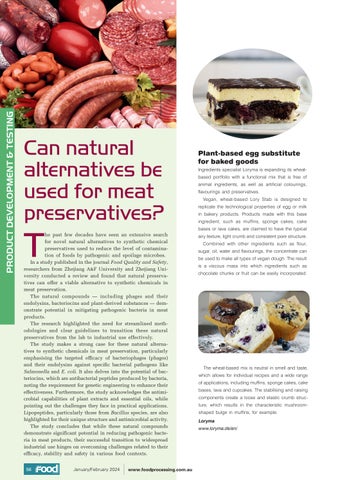PRODUCT DEVELOPMENT & TESTING
iStock.com/ac_bnphotos
Can natural alternatives be used for meat preservatives?
T
Ingredients specialist Loryma is expanding its wheatbased portfolio with a functional mix that is free of animal ingredients, as well as artificial colourings, flavourings and preservatives. Vegan, wheat-based Lory Stab is designed to replicate the technological properties of egg or milk in bakery products. Products made with this base ingredient, such as muffins, sponge cakes, cake bases or lava cakes, are claimed to have the typical
he past few decades have seen an extensive search for novel natural alternatives to synthetic chemical preservatives used to reduce the level of contamination of foods by pathogenic and spoilage microbes. In a study published in the journal Food Quality and Safety, researchers from Zhejiang A&F University and Zhejiang University conducted a review and found that natural preservatives can offer a viable alternative to synthetic chemicals in meat preservation. The natural compounds — including phages and their endolysins, bacteriocins and plant-derived substances — demonstrate potential in mitigating pathogenic bacteria in meat products. The research highlighted the need for streamlined methodologies and clear guidelines to transition these natural preservatives from the lab to industrial use effectively. The study makes a strong case for these natural alternatives to synthetic chemicals in meat preservation, particularly emphasising the targeted efficacy of bacteriophages (phages) and their endolysins against specific bacterial pathogens like Salmonella and E. coli. It also delves into the potential of bacteriocins, which are antibacterial peptides produced by bacteria, noting the requirement for genetic engineering to enhance their effectiveness. Furthermore, the study acknowledges the antimicrobial capabilities of plant extracts and essential oils, while pointing out the challenges they face in practical applications. Lipopeptides, particularly those from Bacillus species, are also highlighted for their unique structure and antimicrobial activity. The study concludes that while these natural compounds demonstrate significant potential in reducing pathogenic bacteria in meat products, their successful transition to widespread industrial use hinges on overcoming challenges related to their efficacy, stability and safety in various food contexts. 56
Plant-based egg substitute for baked goods
January/February 2024
www.foodprocessing.com.au
airy texture, light crumb and consistent pore structure. Combined with other ingredients such as flour, sugar, oil, water and flavourings, the concentrate can be used to make all types of vegan dough. The result is a viscous mass into which ingredients such as chocolate chunks or fruit can be easily incorporated.
The wheat-based mix is neutral in smell and taste, which allows for individual recipes and a wide range of applications, including muffins, sponge cakes, cake bases, lava and cupcakes. The stabilising and raising components create a loose and elastic crumb structure, which results in the characteristic mushroomshaped bulge in muffins, for example. Loryma www.loryma.de/en/
